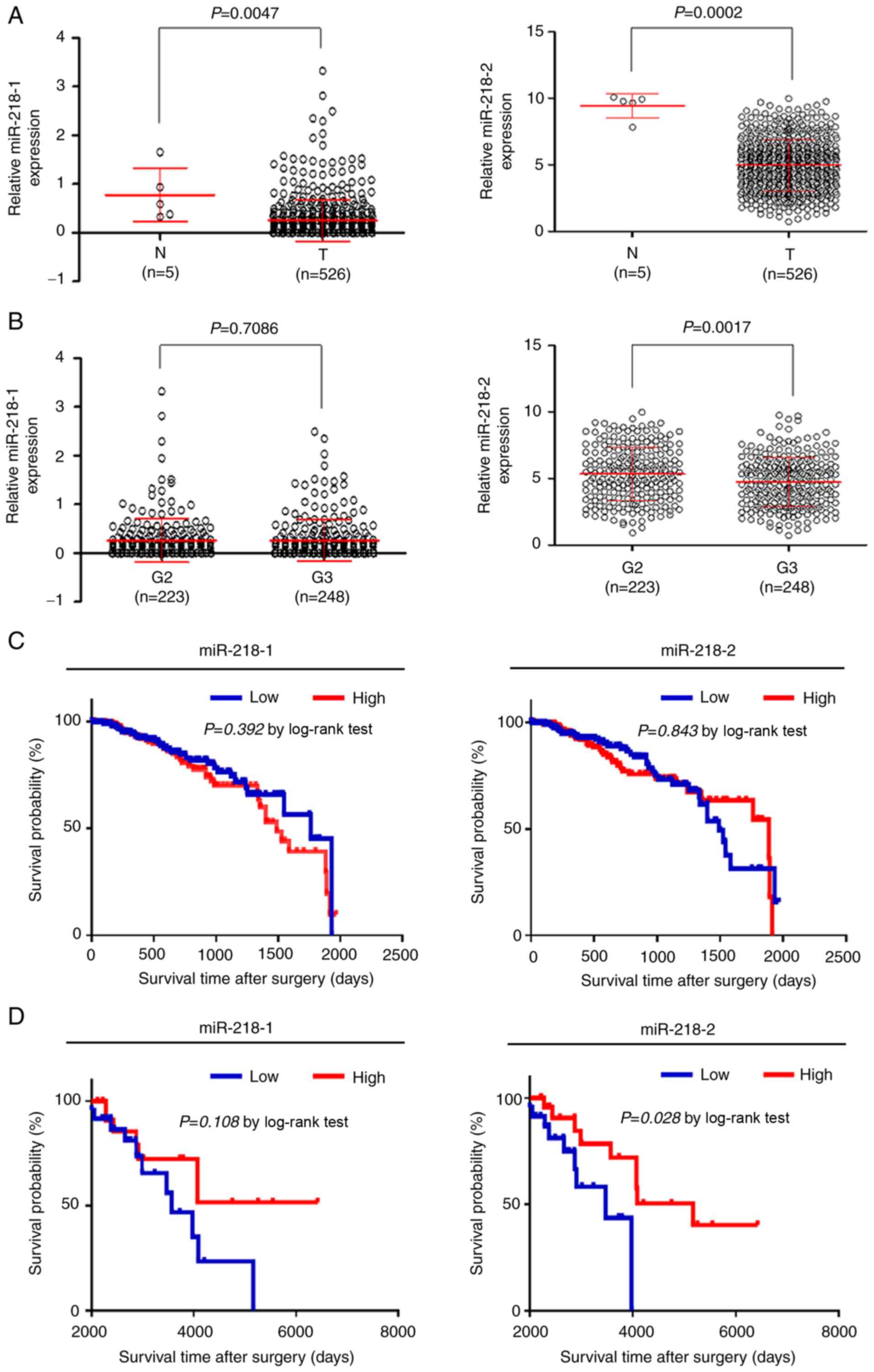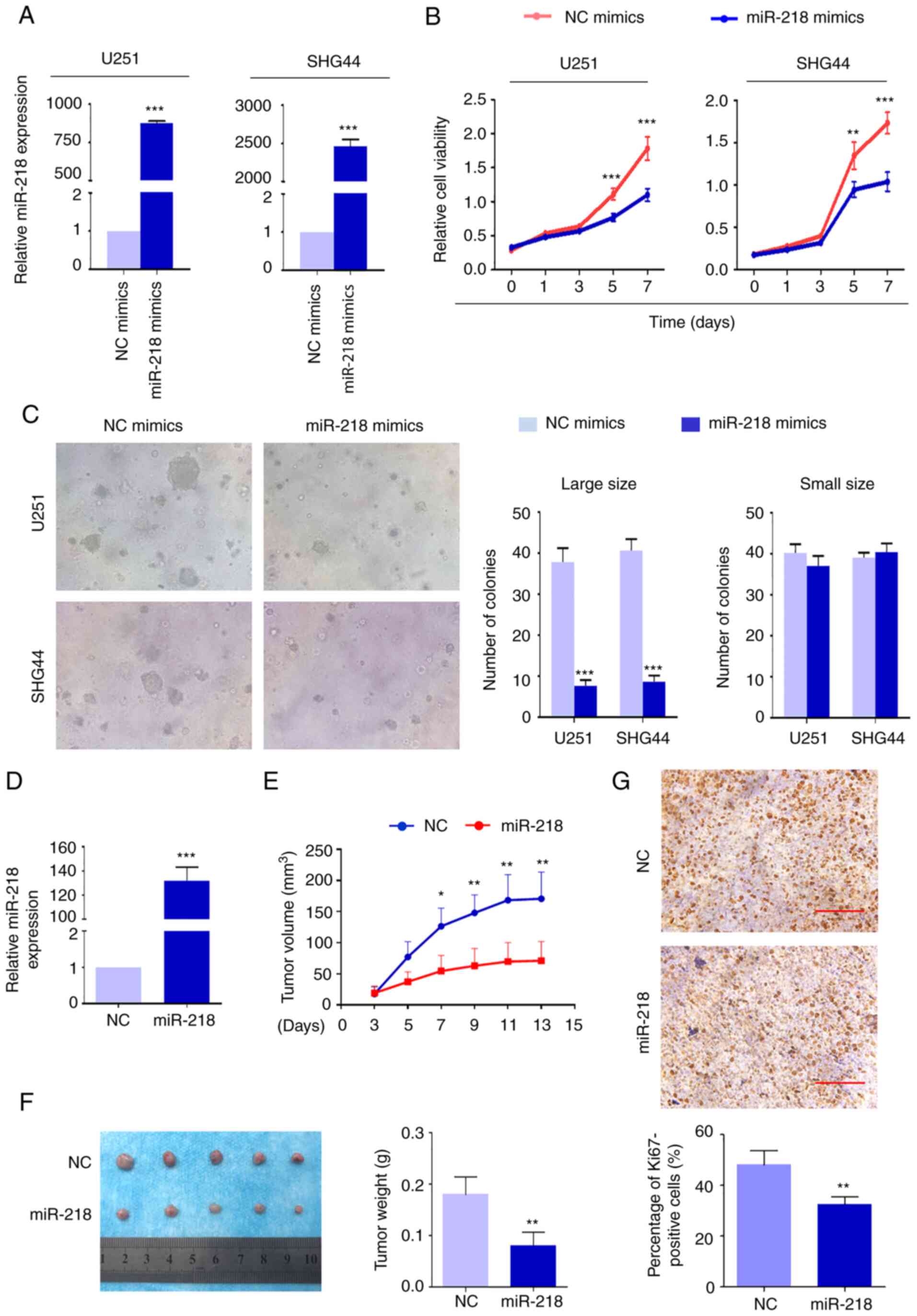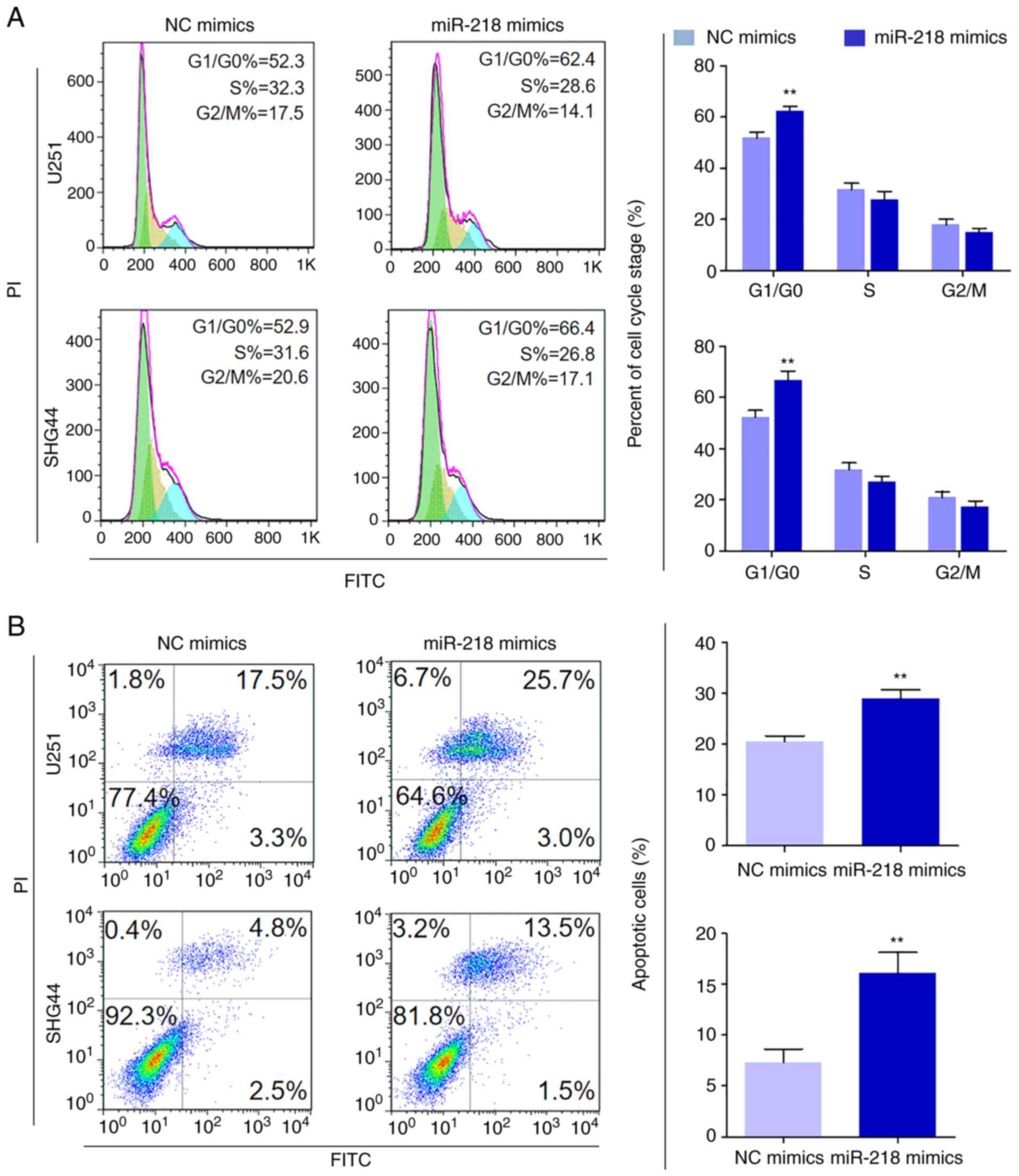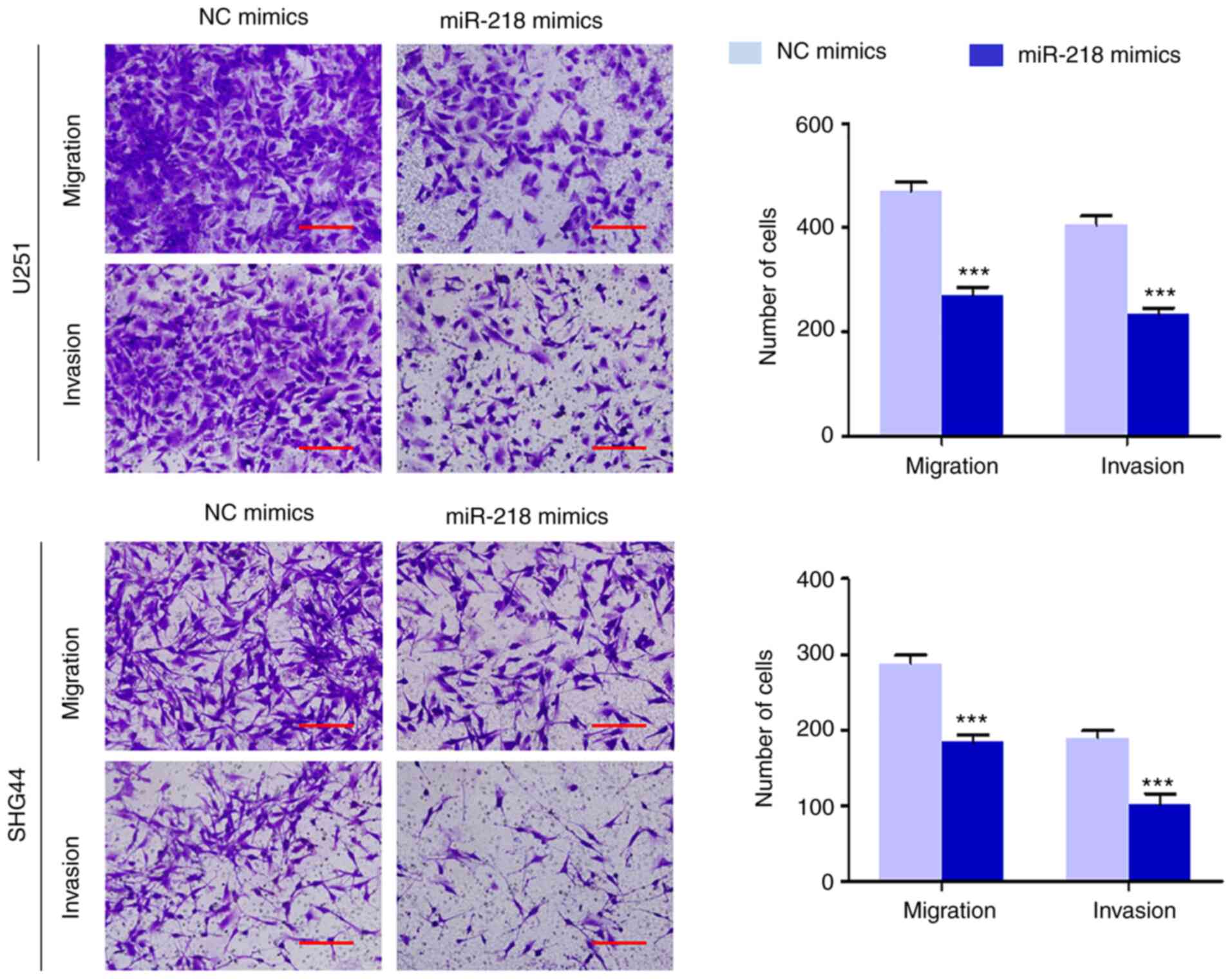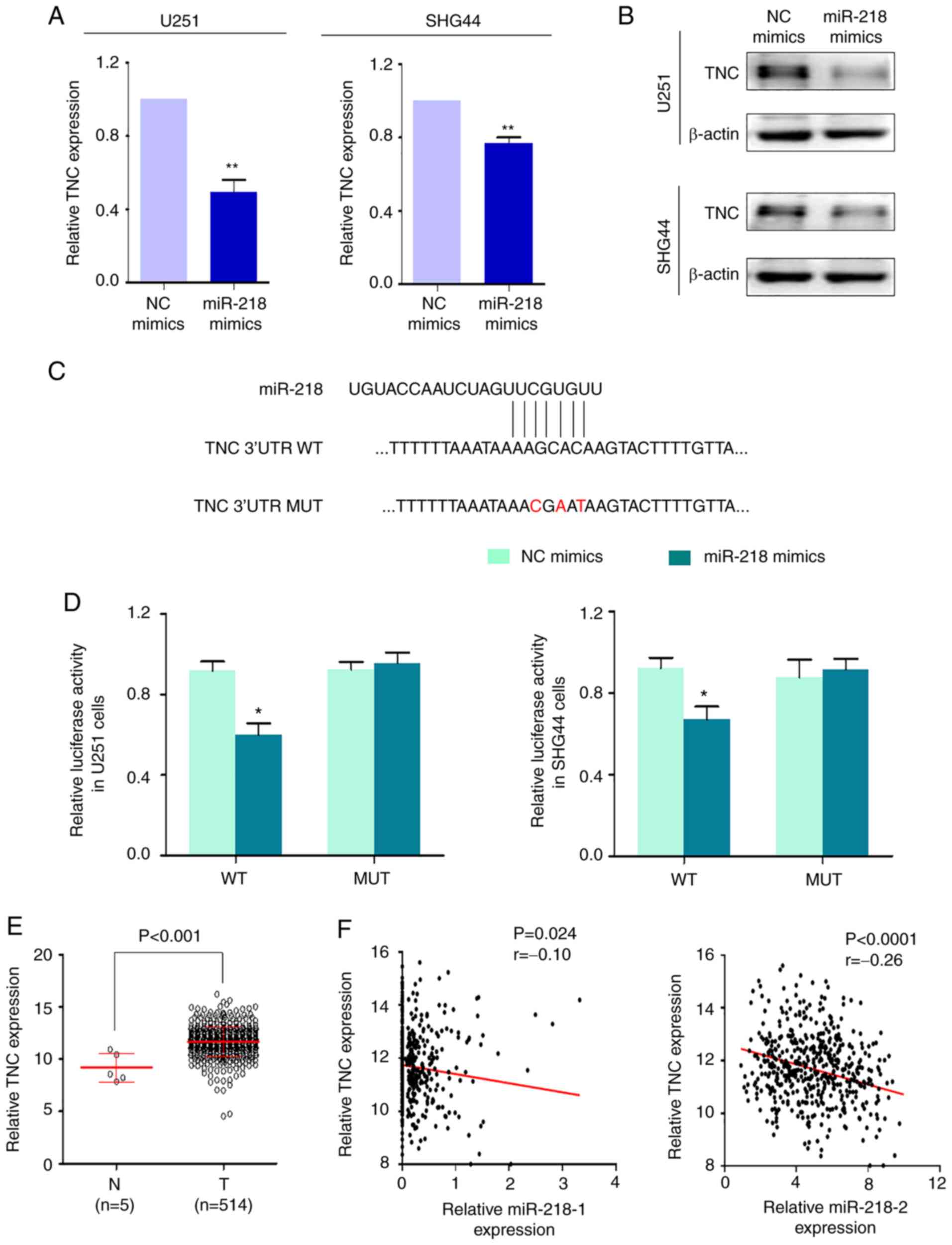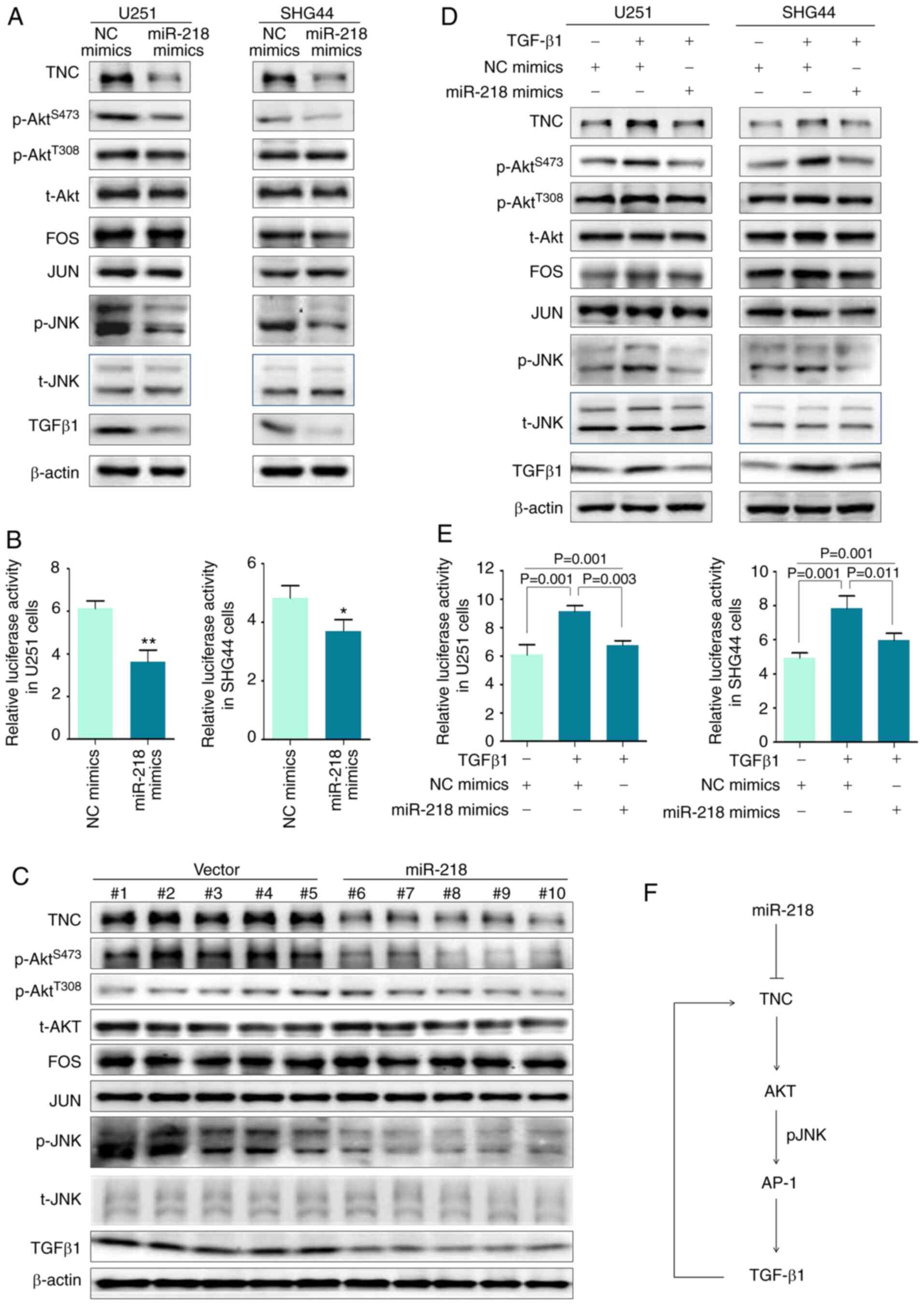|
1
|
Jemal A, Bray F, Center MM, Ferlay J, Ward
E and Forman D: Global cancer statistics. CA Cancer J Clin.
61:69–90. 2011. View Article : Google Scholar
|
|
2
|
Clarke J, Butowski N and Chang S: Recent
advances in therapy for glioblastoma. Arch Neurol. 67:279–283.
2010. View Article : Google Scholar
|
|
3
|
Park DM, Sathornsumetee S and Rich JN:
Medical oncology: Treatment and management of malignant gliomas.
Nat Rev Clin Oncol. 7:75–77. 2010. View Article : Google Scholar
|
|
4
|
Castro MG, Candolfi M, Kroeger K, King GD,
Curtin JF, Yagiz K, Mineharu Y, Assi H, Wibowo M, Ghulam Muhammad
AK, et al: Gene therapy and targeted toxins for glioma. Curr Gene
Ther. 11:155–180. 2011. View Article : Google Scholar
|
|
5
|
Hu J, Sun T, Wang H, Chen Z, Wang S, Yuan
L, Liu T, Li HR, Wang P, Feng Y, et al: MiR-215 is induced
post-transcriptionally via HIF-Drosha complex and mediates
glioma-Initiating cell adaptation to hypoxia by targeting KDM1B.
Cancer Cell. 29:49–60. 2016. View Article : Google Scholar
|
|
6
|
Dang SW, Zhou JS, Chen YJ, Chen P, Ji MJ,
Shi BY, Yang Q and Hou P: Dynamic expression of ZNF382 and its
tumor-suppressor role in hepatitis B virus-related hepatocellular
carcinogenesis. Oncogene. 38:4804–4819. 2019. View Article : Google Scholar
|
|
7
|
Bartel DP: MicroRNAs: Genomics,
biogenesis, mechanism, and function. Cell. 116:281–297. 2004.
View Article : Google Scholar
|
|
8
|
Chen X, Zhang X, Sun S and Zhu M:
MicroRNA-432 inhibits the aggressiveness of glioblastoma multiforme
by directly targeting IGF-1R. Int J Mol Med. 45:597–606. 2020.
|
|
9
|
Liu FZ, Lou K, Zhao XT, Zhang J, Chen W,
Qian YC, Zhao YB, Zhu Y and Zhang Y: miR-214 regulates papillary
thyroid carcinoma cell proliferation and metastasis by targeting
PSMD10. Int J Mol Med. 42:3027–3036. 2018.
|
|
10
|
Park S and James CD: ECop
(EGFR-coamplified and overexpressed protein), a novel protein,
regulates NF-kappaB transcriptional activity and associated
apoptotic response in an IkappaBalpha-dependent manner. Oncogene.
24:2495–2502. 2005. View Article : Google Scholar
|
|
11
|
Frampton AE, Castellano L, Colombo T,
Giovannetti E, Krell J, Jacob J, Pellegrino L, Roca-Alonso L, Funel
N, Gall TM, et al: Integrated molecular analysis to investigate the
role of microRNAs in pancreatic tumour growth and progression.
Lancet. 385(Suppl 1): S372015. View Article : Google Scholar
|
|
12
|
Dvinge H, Git A, Graf S, Salmon-Divon M,
Curtis C, Sottoriva A, Zhao Y, Hirst M, Armisen J, Miska EA, et al:
The shaping and functional consequences of the microRNA landscape
in breast cancer. Nature. 497:378–382. 2013. View Article : Google Scholar
|
|
13
|
Ding PF, Liang B, Shou JX and Wang WJ:
lncRNA KCNQ1OT1 promotes proliferation and invasion of glioma cells
by targeting the miR-375/YAP pathway. Int J Mol Med. 46:1983–1992.
2020. View Article : Google Scholar
|
|
14
|
Song L, Huang Q, Chen K, Liu L, Lin C, Dai
T, Yu C, Wu Z and Li J: miR-218 inhibits the invasive ability of
glioma cells by direct downregulation of IKK-β. Biochem Biophys Res
Commun. 402:135–140. 2010. View Article : Google Scholar
|
|
15
|
Setty M, Helmy K, Khan AA, Silber J, Arvey
A, Neezen F, Agius P, Huse JT, Holland EC and Leslie CS: Inferring
transcriptional and microRNA-mediated regulatory programs in
glioblastoma. Mol Syst Biol. 8:6052012. View Article : Google Scholar
|
|
16
|
Xia H, Yan Y, Hu M, Wang Y, Wang Y, Dai Y,
Chen J, Di G, Chen X and Jiang X: MiR-218 sensitizes glioma cells
to apoptosis and inhibits tumorigenicity by regulating
ECOP-mediated suppression of NF-κB activity. Neuro Oncol.
15:413–422. 2013. View Article : Google Scholar
|
|
17
|
Cheng MW, Wang LL and Hu GY: Expression of
microRNA-218 and its clinicopathological and prognostic
significance in human glioma cases. Asian Pac J Cancer Prev.
16:1839–1843. 2015. View Article : Google Scholar
|
|
18
|
Luo Y, Hou WT, Zeng L, Li ZP, Ge W, Yi C,
Kang JP, Li WM, Wang F, Wu DB, et al: Progress in the study of
markers related to glioma prognosis. Eur Rev Med Pharmacol Sci.
24:7690–7697. 2020.
|
|
19
|
Tatarano S, Chiyomaru T, Kawakami K,
Enokida H, Yoshino H, Hidaka H, Yamasaki T, Kawahara K, Nishiyama
K, Seki N and Nakagawa M: miR-218 on the genomic loss region of
chromosome 4p1531 functions as a tumor suppressor in bladder
cancer. Int J Oncol. 39:13–21. 2011.
|
|
20
|
Erickson HP: Tenascin-C, tenascin-R and
tenascin-X: A family of talented proteins in search of functions.
Curr Opin Cell Biol. 5:869–876. 1993. View Article : Google Scholar
|
|
21
|
Jones PL and Jones FS: Tenascin-C in
development and disease: Gene regulation and cell function. Matrix
Biol. 19:581–596. 2000. View Article : Google Scholar
|
|
22
|
Fassler R, Sasaki T, Timpl R, Chu ML and
Werner S: Differential regulation of fibulin, tenascin-C, and
nidogen expression during wound healing of normal and
glucocorticoid-treated mice. Exp Cell Res. 222:111–116. 1996.
View Article : Google Scholar
|
|
23
|
Zagzag D, Friedlander DR, Miller DC, Dosik
J, Cangiarella J, Kostianovsky M, Cohen H, Grumet M and Greco MA:
Tenascin expression in astrocytomas correlates with angiogenesis.
Cancer Res. 55:907–914. 1995.
|
|
24
|
Zamecnik J: The extracellular space and
matrix of gliomas. Acta Neuropathol. 110:435–442. 2005. View Article : Google Scholar
|
|
25
|
Rolle K, Nowak S, Wyszko E, Nowak M,
Zukiel R, Piestrzeniewicz R, Gawronska I, Barciszewska MZ and
Barciszewski J: Promising human brain tumors therapy with
interference RNA intervention (iRNAi). Cancer Biol Ther. 9:396–406.
2010. View Article : Google Scholar
|
|
26
|
Doecke JD, Wang Y and Baggerly K:
Co-localized genomic regulation of miRNA and mRNA via DNA
methylation affects survival in multiple tumor types. Cancer Genet.
209:463–473. 2016. View Article : Google Scholar
|
|
27
|
Shi J, Liu W, Sui F, Lu R, He Q, Yang Q,
Lv H, Shi B and Hou P: Frequent amplification of AIB1, a critical
oncogene modulating major signaling pathways, is associated with
poor survival in gastric cancer. Oncotarget. 6:14344–14359. 2015.
View Article : Google Scholar
|
|
28
|
Livak KJ and Schmittgen TD: Analysis of
relative gene expression data using real-time quantitative PCR and
the 2(-Delta Delta C(T)) method. Methods. 25:402–408. 2001.
View Article : Google Scholar
|
|
29
|
Shi J, Qu Y, Li X, Sui F, Yao D, Yang Q,
Shi B, Ji M and Hou P: Increased expression of EHF via gene
amplification contributes to the activation of HER family signaling
and associates with poor survival in gastric cancer. Cell Death
Dis. 7:e24422016. View Article : Google Scholar
|
|
30
|
Guan H, Wei G, Wu J, Fang D, Liao Z, Xiao
H, Li M and Li Y: Down-regulation of miR-218-2 and its host gene
SLIT3 cooperate to promote invasion and progression of thyroid
cancer. J Clin Endocrinol Metab. 98:E1334–E1344. 2013. View Article : Google Scholar
|
|
31
|
Jang JH and Chung CP: Tenascin-C promotes
cell survival by activation of Akt in human chondrosarcoma cell.
Cancer Lett. 229:101–105. 2005. View Article : Google Scholar
|
|
32
|
Ding H, Jin M, Liu D, Wang S, Zhang J,
Song X and Huang R: TenascinC promotes the migration of bone marrow
stem cells via toll-like receptor 4-mediated signaling pathways:
MAPK, AKT and Wnt. Mol Med Rep. 17:7603–7610. 2018.
|
|
33
|
Paron I, Berchtold S, Voros J, Shamarla M,
Erkan M, Höfler H and Esposito I: Tenascin-C enhances pancreatic
cancer cell growth and motility and affects cell adhesion through
activation of the integrin pathway. PLoS One. 6:e216842011.
View Article : Google Scholar
|
|
34
|
Xu Z, Liu D, Fan C, Luan L, Zhang X and
Wang E: DIXDC1 increases the invasion and migration ability of
non-small-cell lung cancer cells via the PI3K-AKT/AP-1 pathway. Mol
Carcinog. 53:917–925. 2014. View Article : Google Scholar
|
|
35
|
Wu D, Peng F, Zhang B, Ingram AJ, Kelly
DJ, Gilbert RE, Gao B and Krepinsky JC: PKC-beta1 mediates
glucose-induced Akt activation and TGF-beta1 upregulation in
mesangial cells. J Am Soc Nephrol. 20:554–566. 2009. View Article : Google Scholar
|
|
36
|
Peterziel H, Muller J, Danner A, Barbus S,
Liu HK, Radlwimmer B, Pietsch T, Lichter P, Schutz G, Hess J and
Angel P: Expression of podoplanin in human astrocytic brain tumors
is controlled by the PI3K-AKT-AP-1 signaling pathway and promoter
methylation. Neuro Oncol. 14:426–439. 2012. View Article : Google Scholar
|
|
37
|
Ho E and Ames BN: Low intracellular zinc
induces oxidative DNA damage, disrupts p53, NFkappa B, and AP1 DNA
binding, and affects DNA repair in a rat glioma cell line. Proc
Natl Acad Sci USA. 99:16770–16775. 2002. View Article : Google Scholar
|
|
38
|
Han R, Li L, Ugalde AP, Tal A, Manber Z,
Barbera EP, Chiara VD, Elkon R and Agami R: Functional CRISPR
screen identifies AP1-associated enhancer regulating FOXF1 to
modulate oncogene-induced senescence. Genome Biol. 19:1182018.
View Article : Google Scholar
|
|
39
|
Yao CD, Haensel D, Gaddam S, Patel T,
Atwood SX, Sarin KY, Whitson RJ, McKellar S, Shankar G, Aasi S, et
al: AP-1 and TGFß cooperativity drives non-canonical Hedgehog
signaling in resistant basal cell carcinoma. Nat Commun.
11:50792020. View Article : Google Scholar
|
|
40
|
Karin M, Liu Z and Zandi E: AP-1 function
and regulation. Curr Opin Cell Biol. 9:240–246. 1997. View Article : Google Scholar
|
|
41
|
Kim SJ, Angel P, Lafyatis R, Hattori K,
Kim KY, Sporn MB, Karin M and Roberts AB: Autoinduction of
transforming growth factor beta 1 is mediated by the AP-1 complex.
Mol Cell Biol. 10:1492–1497. 1990.
|
|
42
|
Kim SJ, Jeang KT, Glick AB, Sporn MB and
Roberts AB: Promoter sequences of the human transforming growth
factor-beta 1 gene responsive to transforming growth factor-beta 1
autoinduction. J Biol Chem. 264:7041–7045. 1989. View Article : Google Scholar
|
|
43
|
Yue J and Mulder KM: Requirement of
Ras/MAPK pathway activation by transforming growth factor beta for
transforming growth factor beta 1 production in a Smad-dependent
pathway. J Biol Chem. 275:30765–30773. 2000. View Article : Google Scholar
|
|
44
|
Jinnin M, Ihn H, Asano Y, Yamane K,
Trojanowska M and Tamaki K: Tenascin-C upregulation by transforming
growth factor-beta in human dermal fibroblasts involves Smad3, Sp1,
and Ets1. Oncogene. 23:1656–1667. 2004. View Article : Google Scholar
|
|
45
|
Tie J, Pan Y, Zhao L, Wu K, Liu J, Sun S,
Guo X, Wang B, Gang Y, Zhang Y, et al: MiR-218 inhibits invasion
and metastasis of gastric cancer by targeting the Robo1 receptor.
PLoS Genet. 6:e10008792010. View Article : Google Scholar
|
|
46
|
Alajez NM, Lenarduzzi M, Ito E, Hui AB,
Shi W, Bruce J, Yue S, Huang SH, Xu W, Waldron J, et al: MiR-218
suppresses nasopharyngeal cancer progression through downregulation
of survivin and the SLIT2-ROBO1 pathway. Cancer Res. 71:2381–2391.
2011. View Article : Google Scholar
|
|
47
|
Shi ZM, Wang L, Shen H, Jiang CF, Ge X, Li
DM, Wen YY, Sun HR, Pan MH, Li W, et al: Downregulation of miR-218
contributes to epithelial-mesenchymal transition and tumor
metastasis in lung cancer by targeting Slug/ZEB2 signaling.
Oncogene. 36:2577–2588. 2017. View Article : Google Scholar
|
|
48
|
Martinez I, Gardiner AS, Board KF, Monzon
FA, Edwards RP and Khan SA: Human papillomavirus type 16 reduces
the expression of microRNA-218 in cervical carcinoma cells.
Oncogene. 27:2575–2582. 2008. View Article : Google Scholar
|
|
49
|
Uesugi A, Kozaki K, Tsuruta T, Furuta M,
Morita K, Imoto I, Omura K and Inazawa J: The tumor suppressive
microRNA miR-218 targets the mTOR component Rictor and inhibits AKT
phosphorylation in oral cancer. Cancer Res. 71:5765–5778. 2011.
View Article : Google Scholar
|
|
50
|
Tu Y, Gao X, Li G, Fu H, Cui D, Liu H, Jin
W and Zhang Y: MicroRNA-218 inhibits glioma invasion, migration,
proliferation, and cancer stem-like cell self-renewal by targeting
the polycomb group gene Bmi1. Cancer Res. 73:6046–6055. 2013.
View Article : Google Scholar
|
|
51
|
Jones FS and Jones PL: The tenascin family
of ECM glycoproteins: Structure, function, and regulation during
embryonic development and tissue remodeling. Dev Dyn. 218:235–259.
2000. View Article : Google Scholar
|
|
52
|
Kii I, Nishiyama T, Li M, Matsumoto K,
Saito M, Amizuka N and Kudo A: Incorporation of tenascin-C into the
extracellular matrix by periostin underlies an extracellular
meshwork architecture. J Biol Chem. 285:2028–2039. 2010. View Article : Google Scholar
|
|
53
|
Orend G and Chiquet-Ehrismann R:
Tenascin-C induced signaling in cancer. Cancer Lett. 244:143–163.
2006. View Article : Google Scholar
|
|
54
|
Barrera LN, Evans A, Lane B, Brumskill S,
Oldfield FE, Campbell F, Andrews T, Lu Z, Perez-Mancera PA,
Liloglou T, et al: Fibroblasts from distinct pancreatic pathologies
exhibit disease-specific properties. Cancer Res. 80:2861–2873.
2020. View Article : Google Scholar
|















